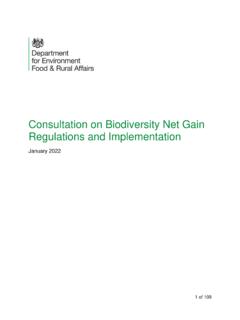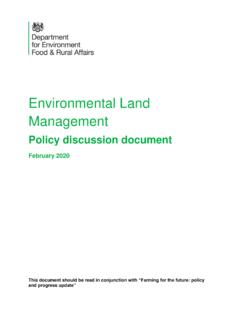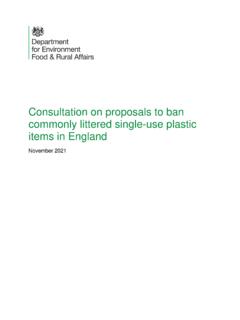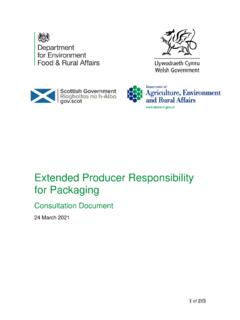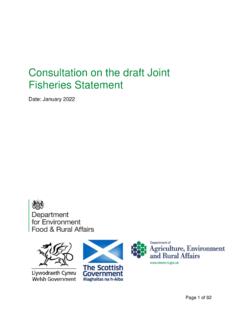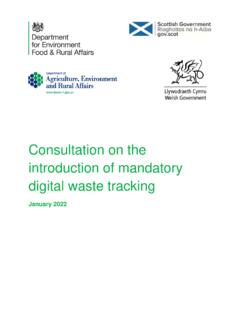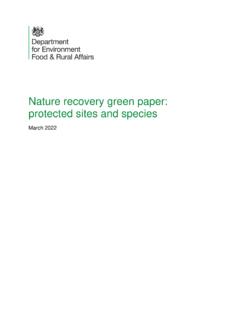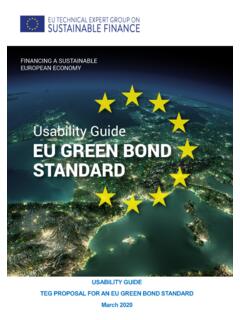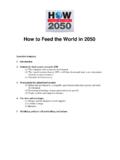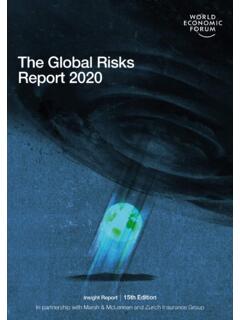Transcription of Waste Prevention Programme for England - GOV.UK
1 Waste Prevention Programme for England Towards a resource efficient economy Consultation version March 2021 We are the Department for Environment, Food and Rural Affairs. We re responsible for improving and protecting the environment, growing the green economy and supporting our world-class food, farming and fishing industries. We work closely with our 33 agencies and arm s length bodies on our ambition to make our air purer, our water cleaner, our land greener and our food more sustainable. Our mission is to restore and enhance the environment for the next generation, and to leave the environment in a better state than we found it. Crown copyright 2021 This information is licensed under the Open Government Licence To view this licence, visit This publication is available at Any enquiries regarding this publication should be sent to us at Contents Chapter 1 Introduction.
2 1 Chapter 2 Designing out Waste : Ecodesign, Extended Producer Responsibility and Consumer Information ..14 Chapter 3 Reuse, Repair, Refill, Remanufacture: local services and facilities ..19 Chapter 4 Data and Information: from industrial symbiosis to research & Chapter 5 Construction ..28 Chapter 6 Textiles ..32 Chapter 7 Furniture ..37 Chapter 8 Electrical and Electronic Chapter 9 Road Vehicles ..46 Chapter 10 Packaging, Plastics and Single-use Items ..52 Chapter 11 Chapter 12 Monitoring and Evaluation ..61 Glossary ..67 1 Chapter 1 Introduction The Resources and Waste Strategy is framed by natural capital thinking and guided by two overarching objectives1: To maximise the value of resource use To minimise Waste and its impact on the environment. The revised Waste Prevention Programme will help deliver the above in order to: Reduce greenhouse gas emissions Reduce the pressure on our natural environment Help safeguard our resource security Increase growth in new sectors Enhance competitiveness by keeping products and materials in circulation Create jobs at all skill levels The Resources and Waste Strategy is underpinned by five strategic principles.
3 To provide the incentives, through regulatory or economic instruments if necessary and appropriate, and ensure the infrastructure, information and skills are in place, for people to do the right thing To prevent Waste from occurring in the first place, and manage it better when it does To ensure that those who place on the market products which become Waste take greater responsibility for the costs of disposal the polluter pays principle To lead by example, both domestically and internationally To not allow our ambition to be undermined by criminality It is intended that the revised Waste Prevention Programme will help embed these principles by setting out steps towards: Transforming product design and supporting factors such as spare part provision Making it easier for consumers to make sustainable purchasing decisions Using extended producer responsibility and other financial incentives to ensure the polluter pays principle is embedded Aligning the regulatory framework with a circular economy approach Integrating the strategic principles into industrial policy and giving first movers the recognition they deserve 1 HM Government (2018) Resources & Waste Strategy 2 Action is already underway to enable action in this respect, in particular through our landmark Environment Bill.
4 We are seeking new powers to drive design for durability, reparability and recyclability of products such as electronics and clothing, including through setting product design requirements, provision of information for consumers, taking forward extended producer responsibility schemes, and introducing charges to discourage single-use plastics. Defra is also working with the Department for Business, Energy & Industrial Strategy to make the most of repatriated EU powers to take forward ecodesign measures relating to energy-using products. Purpose of this document The purpose of this document is to set out for comment the measures which the Government intends to include in our revised Waste Prevention Programme for England . Why do we need to take action on Waste Prevention ? Growing populations and greater demand for products globally are putting increasing pressure on our natural resources and contributing to accelerating climate change.
5 As a result, growing quantities of Waste are becoming an increasing problem, with many countries being reluctant to import Waste . Sustainable consumption and production embodied by UN Sustainable Development Goal (SDG) 12 is vital for achieving transformative change. Using resources efficiently is one of the main pillars of this SDG, and we regard Waste Prevention as critical in this respect. Waste Prevention is often the most efficient way of addressing these pressures, as it reduces unnecessary production and processing, and therefore costs, as well as carbon emissions associated with those steps. For this reason, it is at the top of the Waste hierarchy. Waste Prevention has huge potential: products and materials need not become Waste . Products can be designed to support longer product lifetimes, and enable reuse, repair and remanufacture.
6 We can reduce those products and types of packaging that are hard to reuse and recycle, such as plastic films. Manufacturers can use Waste products of other industries as inputs whether this be Waste foundry sand or salty whey from cheese making. We can repair and remanufacture products locally. This is a win-win strategy in terms of economic efficiency, the environment, and jobs and growth in the UK. 3 Figure 1: Preventing Waste across the product lifecycle How will the Waste Prevention Programme relate to Our Waste , our resources: A strategy for England ? Our Waste , our resources: a strategy for England , referred to here as the Resources and Waste Strategy, states how we will better manage our material resources: how we will promote resource efficiency, move towards a circular economy, and minimise the residual Waste produced.
7 It aims to safeguard our natural capital: reducing greenhouse gas (GHG) emissions, mitigating risks from chemicals, and reducing the impacts of extraction on our natural environment. It sets out a comprehensive and overarching approach, covering in depth the immediate actions that need to be taken. 4 We will seek to build on this through the revised Waste Prevention Programme focusing on the top of the Waste hierarchy, which means increasing reuse, repair and remanufacture, as well as use of industrial by-products. Our goal is to develop the key cross-cutting and sector-specific aspects of the Strategy. The aim is to embed our circular economy approach and retain products and goods in circulation for as long as possible and at their highest value. Figure 2: Evolution of Waste Management Practices 5 What are we required to do under current legislation?
8 The Waste Prevention Programme for England was published in December 2013 as required by the Waste ( England and Wales) Regulations The Programme complements the Waste Management Plan for England on recycling and residual Waste management. How does Waste Prevention relate to our wider environmental and industrial goals? Delivery of Strategic Targets & Commitments 25 Year Environment Plan work towards eliminate avoidable Waste by 2050 25 Year Environment Plan work towards eliminating food Waste to landfill by 2030 Industrial Strategy double resource productivity by 2050 Climate Change Act net zero domestic greenhouse gas emissions by 2050 Resources & Waste Strategy increase municipal recycling rate to 65% by 2035 Resources & Waste Strategy no more than 10% of municipal Waste to landfill by 2035 Waste Prevention has numerous benefits, explained below.
9 It will help us develop a more resource productive economy, vital for a 21st century economy, as well as protecting our natural capital. To support our drive towards resource productivity, we are exploring setting a relevant statutory target to meet the target-setting duty we expect to have once our landmark Environment Bill becomes law. Natural capital: water, air and biodiversity Keeping products and materials in use for longer reduces the pressure on our natural environment. Globally, we extract three times the amount of resources from nature than we did in 1970, and this is estimated to more than double by 2060. The International Resources Panel estimates that the extraction and processing of materials, fuels and food make up about 50% of total global greenhouse gas emissions and more than 90% of biodiversity loss and water 2 3 International Resources Panel, global Resources outlook 2019 6 Greenhouse gas emissions Ambitious action will help the UK reduce its domestic emissions (approximately 450Mt CO2e in 2018)4 in support of achieving domestic carbon budgets.
10 This is because emissions from manufacturing make up at least 17% of our domestic emissions. 5 In addition, action will help reduce emissions related to the production of goods and services consumed here but generated overseas. The UK s consumption-based emissions or global carbon footprint stood at approximately 770 MtCO2e in Research estimates that from just five key sectors (construction, vehicles, food, textiles, and electronics) UK domestic emissions can be reduced by approximately 31 MtCO2e by keeping products in use for longer, reusing rather than recycling, and sharing items such as tools and machinery. 7 Better product design and increased reuse can deliver even more, estimates suggest a reduction of 81 MtCO2e is possible between now and 2050 through a series of measures. 8 Reuse saves more than recycling: for example, reuse of steel saves kg CO2 per kg more than Waste Prevention policy relates to the Industrial Decarbonisation Strategy which sets out the Government s vision for a prosperous, low carbon UK industrial sector in 2050.
